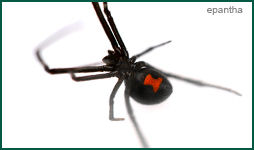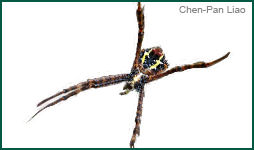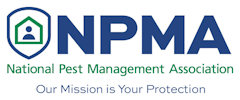Many species of spiders are common household pests in the United States. Certain common household spiders (hobo spiders, black house spiders) spin webs over lamps, in corners, and basements. Other outdoor spiders make large webs spanning walkway (orb weavers and cross weavers) which can be annoying and frightening to walk into. This creates an unsightly mess, but causes no real harm. Remember that every cobweb was made by a spider. Remember that spiders are beneficial pests, being that they help keep other more troublesome pests in check. All spiders are venomous, and use that venom to kill their prey, but are usually non-hazardous to humans and pets. However there are two spiders that are hazards to people and pets, and should be taken care of immediately. Those being the Brown Recluse and the Black Widow.
Brown Recluse Spider

Brown Recluse Spider - (Loxoscelesreclusa)
ID: The brown recluse spider are usually between 1/4”-3/4” or 6-20mm around, but can occasionally grow larger. While typically a light to medium brown, they range in color from cream-colored to dark drown or blackish gray. The cephalothorax and abdomen may not necessarily be the same color. These spiders are well-known for their markings on the dorsal side of the cephalothorax with a black line stemming from it resembling a violin with the neck of the violin pointing at the rear of the spider, resulting in the nicknames: Fiddleback, Brown Fiddler, and Violin Spider.
Adult Brown Recluse spiders often live about one to two years. Each female produces several egg sacs over a period of two to three months, from May to July, with approximately fifty eggs in each sac. The eggs hatch in about one month. The spiderlings can take about one year to grow into adulthood. The brown recluse is resilient and can tolerate up to six months of extreme drought and scarcity or absence of food. On one occasion it survived in controlled captivity for over five season without food.
The Brown Recluse bite does not induce a lot of pain at first, so often the bite itself goes unnoticed. The spider produces a deadly hemotoxic venom which can result in necrosis if left untreated. Most bites are minor, exhibiting little to no trauma. If you suspect that you have been bitten, try to capture the spider and go to the nearest emergency room with the spider sample intact.
Black Widow Spider

Black Widow - Latrodectus (subspecies include L. mactans, L. hesperus, and L. variolus)
ID:Females of most Latrodectusspecies are dark or black in color with a sheen and usually exhibits a red or orange hourglass on the ventrum underside or bottom of the abdomen. Some may have a pair of red spots or possibly no markings at all. They often exhibit various red or white markings on the topside of the abdomen, ranging from single stripe to bars or spots. Females of a few species are paler, browner shades and some have no bright markers. Juveniles and adult male Black Widow Spiders are half the size of the females, and are often gray or brown and usually lighter in color than the females; while they may sometimes have an hourglass marking on their ventral abdomen, it may be yellow or white, not red.
Black Widows construct a web of irregular, tangled, sticky silken fibers. Black Widows prefer to nest near the ground in dark and undisturbed areas. Usually in small holes produced by animals, or around construction openings or wood piles. Indoor nests are in dark, undisturbed places as well such as; under desks or furniture, in the basement. If the spider perceives a threat, it quickly lets itself down to the ground on a safety line of silk. When a widow spider is trapped, it is unlikely to bite, preferring to play dead or flick silk at the potential threat; bites are the result of continual harassment. While some species are more aggressive, most are not; many injuries to humans are due to defensive bites delivered when a spider gets unintentionally squeezed or pinched.
Due to the presence of latrotoxin in their venom, black widow bites are potentially dangerous and may result in severe muscle pain, abdominal cramps, abnormal sweating, fast heart rate, and muscle spasms. Symptoms usually last for 3–7 days, but may persist for several weeks. Contrary to popular belief, most people who are bitten suffer no serious damage, let alone death. Even so if you suspect that you have been bitten, try to capture the spider and go to the nearest emergency room with the spider sample intact.
St. Andrew's Cross Spider

St. Andrew’s Cross Spider - (Argiope)
ID: These are rather large, weaving spiders black-and-yellow in coloring and their web’s contain a thick, reflective stabilimentia that resembles a cross or writing. They common make their webs around arounds between two spanning structures. These spiders are harmless and non-aggressive, but the bite is painful comparable to a bee sting.
Spotted Orb Spider

Spotted Orb Weaver - Neoscona crucifera
ID: These are rather large, bulbous spiders that commonly make massive webs which can span entire walkways. They are generally brown in color and have brightly colored spots on the underside of their abdomen. These spiders are harmless and non-aggressive, but can attract a large variety of wasps and hornets to the areas, as they are prey to them. Their bite is relatively non-painful and may produce swelling.
There are many other different of species of spiders that can invade your home and garden. We do offer many Spider treatment options, which include treating the molding of rooms, baseboard sprays, and exterior treatments. We also inspect the insides of cabinets, behind plumbing, and garages where spiders tend to be hiding. A general pest treatment also usually covers the prey that spiders tend to hunt and this will also reduce the frequency of spiders in your property.




